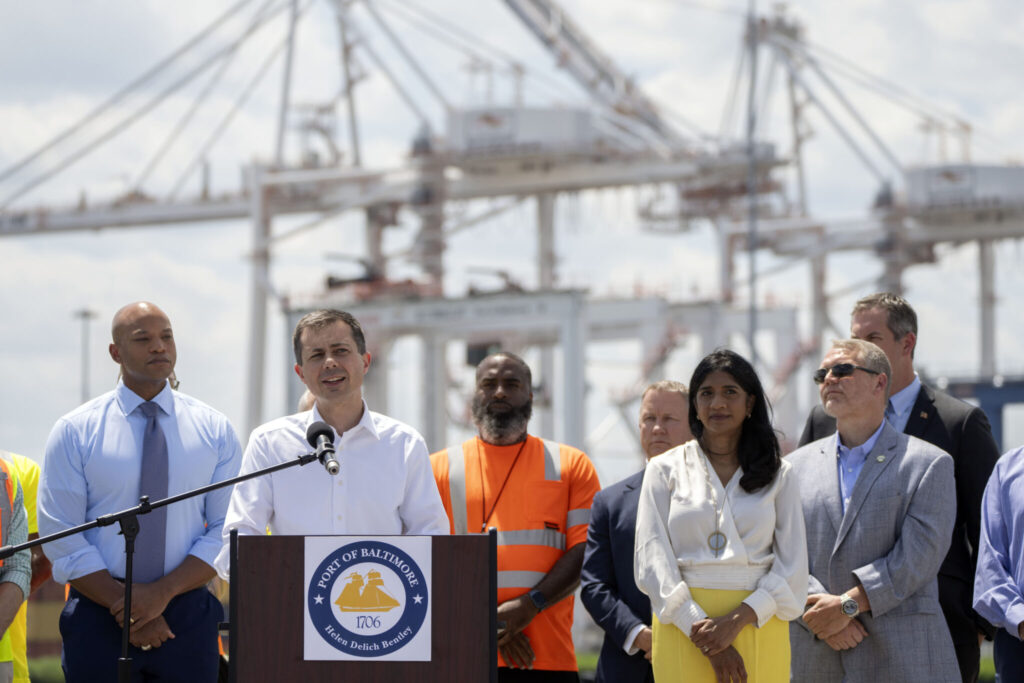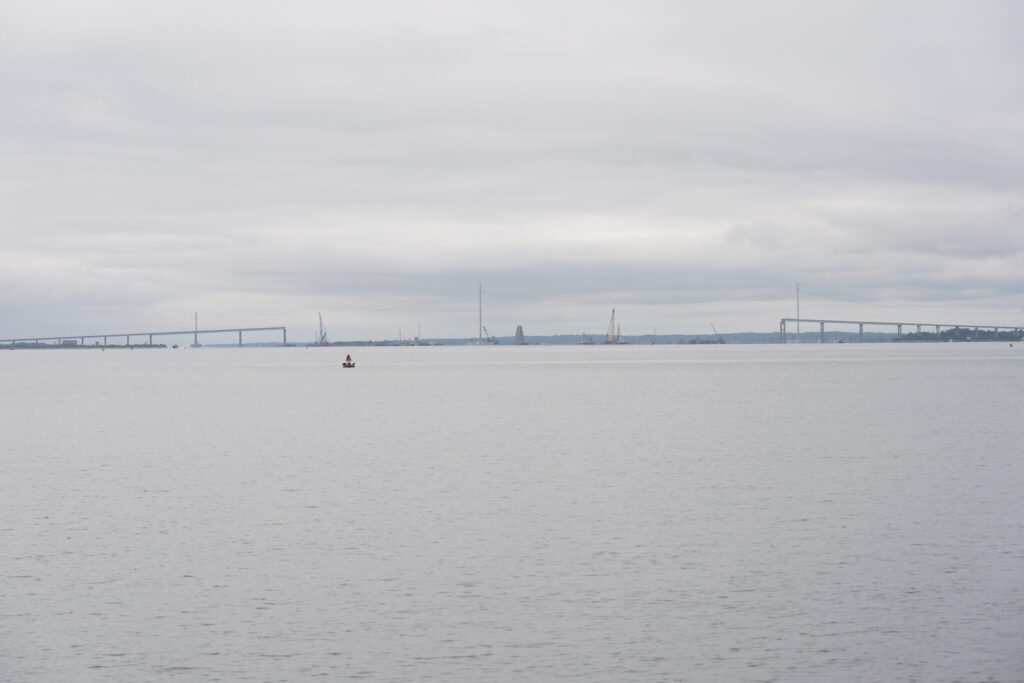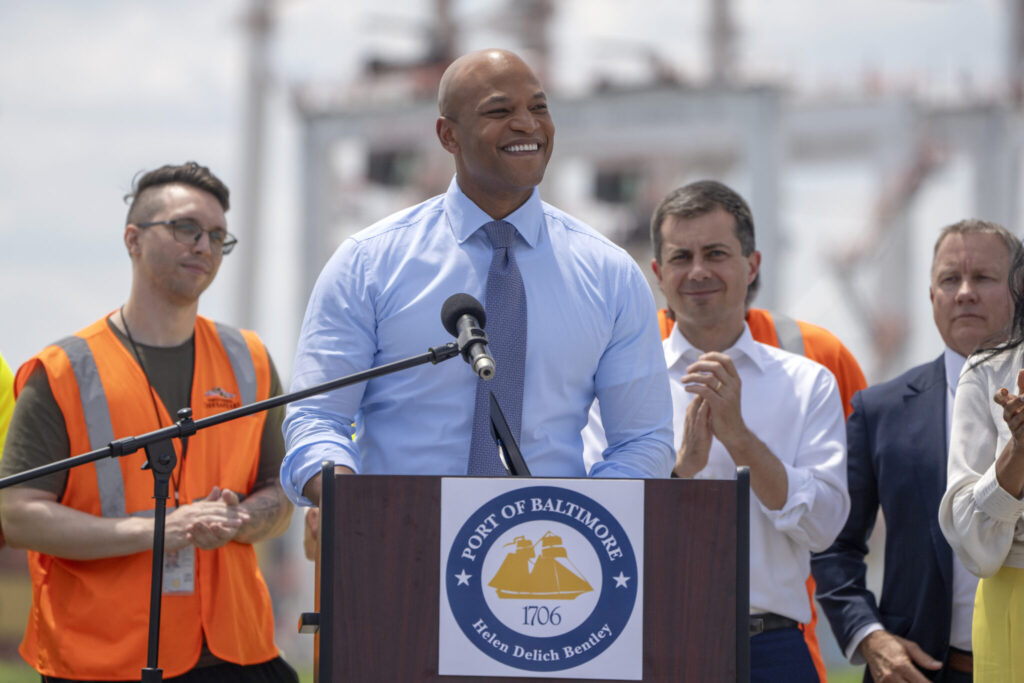Commercial shipping traffic through the Port of Baltimore is expected to return to normal levels next month, officials said Wednesday, after the channel fully reopened this week for the first time since the collapse of the Francis Scott Key Bridge in March. “I’ve been waiting to say this for every day for the last 11 weeks: Maryland, the Fort McHenry Channel is fully cleared, and the Port of Baltimore is reopened for business,” Gov. Wes Moore said at a waterside news conference to highlight the milestone. As the governor spoke, a passing ship blasted its horn. “You hear that?” Moore said. “That’s a beautiful sound.”
Quick Read
- Baltimore’s busy port has fully reopened after the collapse of the Francis Scott Key Bridge in March, with normal commercial shipping traffic expected to resume next month.
- Maryland Governor Wes Moore announced the reopening at a news conference, celebrating the clearance of the Fort McHenry Channel.
- The collapse halted most maritime traffic, necessitating a $160 million salvage effort involving federal, state, and local agencies to clear 50,000 tons of debris from the Patapsco River.
- The U.S. Army Corps of Engineers’ salvage operations cost up to $75 million, with the Coast Guard’s response costing $24 million. Maryland utilized $60 million in federal emergency funds to open smaller channels.
- Companies that rerouted cargo during the cleanup are expected to return, with the port processing more cars and farm equipment than any other in the country.
- Transportation Secretary Pete Buttigieg emphasized that commercial traffic belongs in Baltimore and is expected to return.
- Portions of the deep-draft channel reopened in phases, allowing some commercial traffic, including cruise and large container ships, to pass through in recent weeks.
- The bridge rebuild could cost nearly $2 billion, with completion hoped for by 2028. President Joe Biden pledged federal support for the full cost, pending congressional approval.
- The collapse resulted from the cargo ship Dali losing power and crashing into a bridge support column, causing six deaths. Investigations by the National Transportation Safety Board and the FBI are ongoing.
- The Dali was refloated on May 20, allowing the channel to reopen, with full two-way traffic now resuming and additional safety requirements lifted.
The Associated Press has the story:
Baltimore’s busy port fully reopens after bridge collapse, a return to normal is expected
Newslooks- BALTIMORE (AP) —
Commercial shipping traffic through the Port of Baltimore is expected to return to normal levels next month, officials said Wednesday, after the channel fully reopened this week for the first time since the collapse of the Francis Scott Key Bridge in March.
“I’ve been waiting to say this for every day for the last 11 weeks: Maryland, the Fort McHenry Channel is fully cleared, and the Port of Baltimore is reopened for business,” Gov. Wes Moore said at a waterside news conference to highlight the milestone.
As the governor spoke, a passing ship blasted its horn.
“You hear that?” Moore said. “That’s a beautiful sound.”
Some shipping companies rerouted their cargo to other ports following the deadly collapse in March. The disaster halted most maritime traffic through Baltimore’s busy port as crews worked around the clock to clear an estimated 50,000 tons of fallen steel and concrete from the Patapsco River.
The salvage effort cost roughly $160 million, with federal, state and local agencies involved, officials said.
Officials estimated that the salvage operations for the U.S. Army Corps of Engineers will cost up to $75 million, while the Coast Guard response has cost $24 million to date to open the main channel. Maryland used about $60 million in federal emergency funds to open three other smaller channels outside the main one.

Companies that steered clear of Baltimore during the cleanup will likely come back now that the channel has been returned to its original depth and width, officials said. The port processes more cars and farm equipment than any other in the country.
All that rerouted commercial traffic “belongs in Baltimore today,” U.S. Transportation Secretary Pete Buttigieg said. “We have every indication that that is what is taking place, but we will be reinforcing that expectation as we speak with players up and down the supply chains.”
Crews were able to reopen portions of the deep-draft channel in phases, restoring some commercial traffic in recent weeks. Some cruise ships and large container ships have already passed through, officials said.
But thousands of longshoremen, truckers and small business owners have seen their jobs impacted by the collapse and its economic ripple effects, which extend well beyond the Baltimore region. State officials helped establish several relief programs to keep people employed and businesses afloat in the immediate aftermath.
Rebuilding the bridge could cost nearly $2 billion, officials have said. They hope it’s completed by 2028.
President Joe Biden has pledged that the federal government will cover the full cost of rebuilding, though officials said the funding is still awaiting approval from Congress.
In a statement Tuesday, Biden praised the work of everyone involved in the recovery effort.
“Baltimore can count on us to stick with them every step of the way, and we will continue to have your back until the bridge is rebuilt,” he said.

The cargo ship Dali lost power and crashed into a critical support column of the Francis Scott Key Bridge in the early hours of March 26, collapsing the span and sending six members of a roadwork crew plunging to their deaths.
A National Transportation Safety Board investigation found that the vessel experienced power outages before starting its voyage, but the exact causes of the electrical issues have yet to be determined. The FBI is also conducting a criminal investigation.
The Dali remained stuck amid the wreckage for almost two months, with a massive steel truss draped across its damaged bow, before being refloated and guided back to port May 20. That allowed officials to open a channel that was 50 feet (15 meters) deep and 400 feet (122 meters) wide, big enough for most of the largest commercial vessels.
The full federal shipping channel is 700 feet (213 meters) wide. Officials said two-way traffic can now resume, and additional safety requirements have also been lifted because of the increased width.







